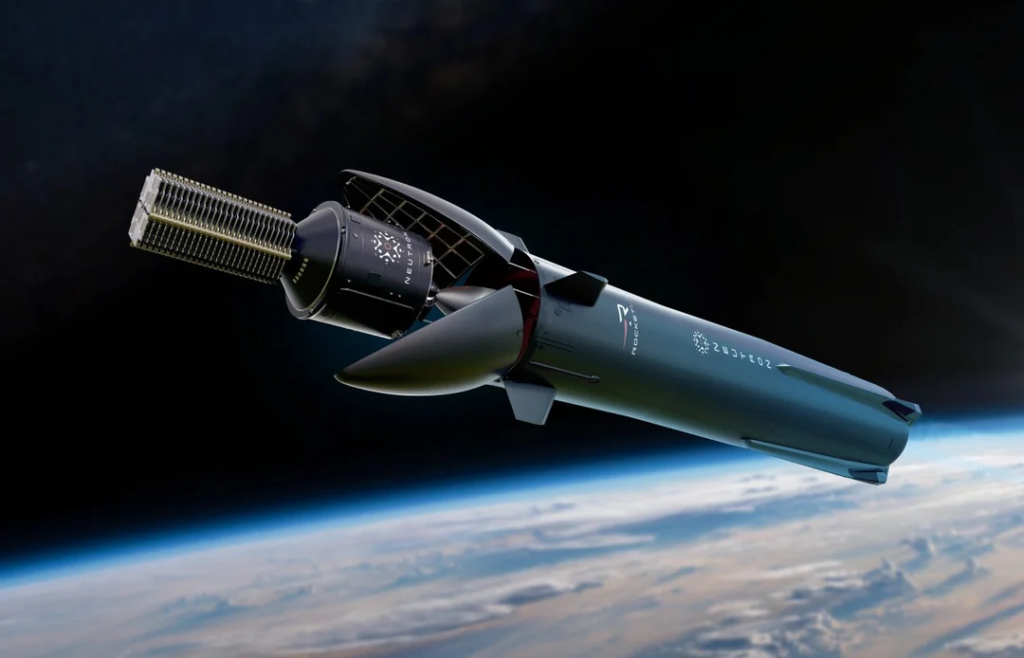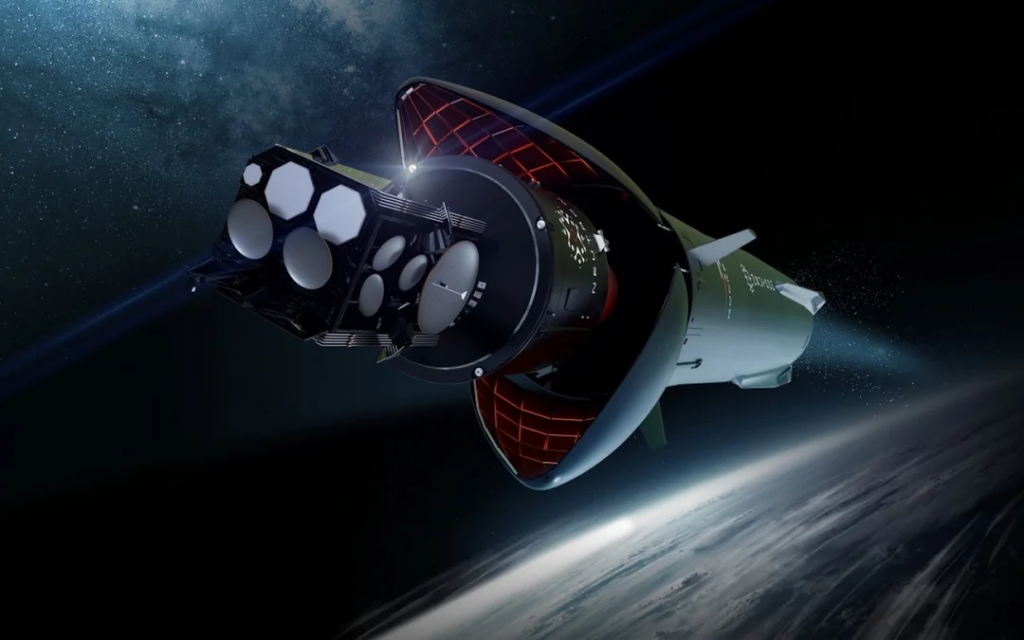
A Closer Look At Neutron’s New Design
Rocket Lab has been busy designing, manufacturing, and testing components for the partially reusable Neutron rocket. Even since its first announcement not long ago relative to the space industry, a lot has changed design-wise. This being said, the primary goal and some of its major features have stayed the same, the company has just found a more efficient way to achieve it.
Only days ago they released a few new images of the updated design which looks much more like the final results and what we can eventually expect to fly. Each illustration gives some new insight into how exactly Neutron will achieve its ambitious payload deployment and recovery operations. Combing this with physical work and development, and Rocket Lab is getting close to some initial testing.
Major components including the Archimedes engine and even the rocket’s tanks are taking shape. With the maiden flight still scheduled for late next year, Rocket Lab will need to keep this fast pace up. Here I will go more in-depth into the new design, what changes were made from past renders, the progress being made, and more.
New Design

It’s important to point out that while there have been some pretty big exterior changes to the rocket, its main goal and design have stayed the same. The rocket is still marketed as a reliable and cost-effective launch service for constellation deployment, cargo resupply, and interplanetary missions.
Looking at the first image, there are a few things that stand out right away. For one, the fairings look much smaller than original designs. In the past, the fairings stretched to almost 1 third of the rocket’s length. Now they are much more compact and only take the up the top portion of Neutron. In addition, the updated design highlights that there are only two fairing halves rather than four. While this was announced a long time ago the new images give a better representation.
The design is quite unique and has the two fairings attached to the first stage. They simply open wide to deploy the payload before closing shut and returning to the ground for a landing with the rest of the stage. Rocket Lab calls this design the hungry hippo fairings.
Moving on, in relation to the smaller fairing the canards toward the top of Neutron are now much higher on the rocket. They obviously needed to be below the fairings which in the past meant they were closer to the middle of the rocket rather than the top. Now they should be able to provide an even more stable descent for recovery operations.
Another difference has to do with the taper of the rocket. Rocket Lab knows that reusability is key to enabling frequent and affordable launch, so the ability to launch, land and lift-off again has been built into every aspect of Neutron’s design from day one. One of the most important parts revolves around Neutron’s unique shape, a tapered rocket with a wide base to provide a robust, stable base for landing, eliminating the need for complex mechanisms and landing legs. In the newest images, there seems to be a bit less of a taper going from bottom to top. This likely has to do with the shorter fairings as they tapered a lot in past designs.
At the bottom of the rocket, you can also see an upgraded landing leg system. Specifically, they show retractable landing legs built into the strakes. This should help a lot with the aerodynamics of Neutron and even lower the weight compared to built-in solid legs.
Lastly, we got an even closer look at the upper stage and some details along with it. You can see somewhat of a beefier stage design with the addition of thrusters and various features. Thanks to the ‘Hungry Hippo’ fairing design, the entire second stage will be completely enveloped within the Neutron’s first stage structure and fairing during launch. Neutron’s second stage is designed to be the lightest in history to enable high performance for complex satellite deployments. Typically, a second stage forms part of the launch vehicle’s exterior structure and needs to provide strength to the vehicle from lift-off, exposing it to the harsh environments of the lower atmosphere during launch. By being housed inside the first stage and ‘Hungry Hippo’ fairing, the requirement for the second stage to withstand the launch environment is eliminated and the second stage can be made significantly lighter enabling higher performance in space.
Neutron Progress

With a better idea of what the rocket will eventually look like, we can focus on the physical progress and what Rocket Lab has been up to. While for the most part, the company has been keeping somewhat quiet, they do occasionally share some information on the rocket. For example, last month, Rocket Lab was quoted saying, “Neutron’s second stage test stand taking shape ahead of cryogenic structural stage testing” This included an image of the test stand. Even Rocket Lab CEO Peter Beck commented, “Getting ready to do some big tank testing.” Based on these comments it was obvious some structural testing was right around the corner but there were no specifics provided
Only a few days later however Rocket Lab commented that, “Supporting Neutron to first launch are our facilities like this Neutron test stand, ready to receive a full-scale second stage tank for structural & cryogenic testing in the coming weeks.” This included an image of the test stand with full propellant lines running around it. At this point, the test stand has been tested and is ready to receive the upper stage. Being that these comments were made just over a month ago, it’s possible that they have already completed upper stage cryogenic testing. This would be a significant milestone in the program and highlights the progress the company is making.
This being said, in all likelihood, this test will reveal a few issues with the system that the Rocket Lab team will need to address as they develop Neutron. When it comes to next generation rockets, this is a common theme as they enter new territory for the first time. Rocket Lab knows small launch and Electron very well but Neutron is a different type of rocket. With this will come new challenges and variations. Designed as an expendable upper stage for now, Neutron’s second stage is a six-meter-long carbon composite structure with a single vacuum optimized Archimedes engine. While this won’t specifically play a big role in the upcoming test, the article will look somewhat out of place on the test stand. When it’s not enveloped within the main Neutron structure, the upper stage is very barren as described.
Even the material is unique in a lot of ways and needs to be thoroughly tested. Originally, Rocket Lab pioneered the use of carbon composite for orbital rockets with the Electron rocket, which has been delivering frequent and reliable access to space for government and commercial small satellites since 2018. Neutron’s structure will be comprised of a new, specially formulated carbon composite material that is lightweight, strong and can withstand the immense heat and forces of launch and re-entry again and again to enable frequent re-flight of the first stage. To enable rapid manufacturability, Neutron’s carbon composite structure will be made using an automated fiber placement system which can build meters of carbon rocket shell in minutes. The upcoming pressure test will see how much this new material and stage can handle.
In addition, looking at the Archimedes Engine schedule, we should expect a few big tests very soon based on what Rocket Lab has said. During the Investor Day Presentation last year, they expected to start preburner testing in 2022, hopefully starting full engine testing at Stennis before 2023 ends, and hoped to be able to launch in 2024. So far they have been just a few months behind this goal. Early this year in January Rocket Lab completed a big milestone in the development of Archimedes. Here they tested engine ignition on dev hardware. At the time they mentioned that the next step would be hot firing hardware with full propellant flow rates to verify injector performance. While the goal was to start full engine testing this year, it’s possible with 5 months left however the most realistic timeframe is around early next year.
While these engine tests are important, Rocket Lab has put a lot of time and money into the development of the upper stage in particular, making its upcoming tests an even bigger deal. Back in late 2021, the company was awarded a $24.35 million contract with the U.S. Space Force’s Space Systems Command (SSC) for development of the Neutron launch vehicle’s upper stage. The agreement signified Rocket Lab’s commitment to becoming a launch provider for the National Security Space Launch (NSSL) program, which launches the United States’ most critical missions.
Peter Beck was quoted saying, “We’re dedicated to building a next-generation rocket that will transform space access for constellations through to the most critical missions in support of national security, and it’s an honor to be partnering with the U.S. Space Force to develop Neutron. This award is a vote of confidence in Neutron and our ability to deliver low-cost, responsive, dedicated launch for the U.S. Government. We’ve built a trusted launch system with Electron, and we’ll do it again with Neutron to continue providing unfettered access to space with our new heavier-lift vehicle” he said. Something we can look forward to seeing more of in the near future.
Conclusion
Rocket Lab just updated the Neutron design with new illustrations of the next gen vehicle. These give us a better idea of what the final product will look like and how it’s expected to change constellation launch services. We will have to wait and see how it progresses and the impact it has on the space industry.
